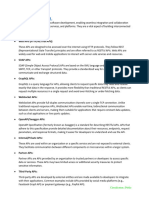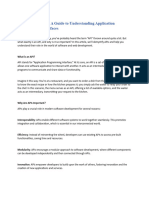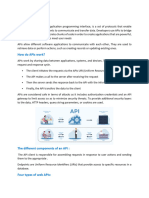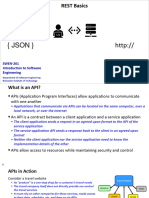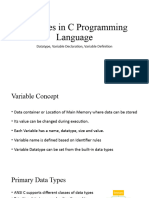Noor-ul-ain Saqib(005)
Syed Shaf Shah(039)
SUMMARY OF GITHUB AND API’S
GitHub: Overview and Features
GitHub is a cloud-based hosting service used for version control and collaboration. It allows users to
store, track, and manage projects without relying on local storage.
Key Features:
1. Version Control: Keeps track of file changes and project progress.
2. Collaboration: Enables teamwork through repositories and pull requests.
3. Open Source: Facilitates contributions to public projects.
GitHub vs Git
GitHub: Enhances Git by adding collaboration and hosting capabilities but requires Git to
function.
Git: A standalone version control software that operates independently of GitHub.
GitHub Essentials
Repository (Repo): Central storage for project files and version history.
Branches: Allow concurrent work and reduce conflict risks.
README Files: Provide detailed descriptions and project instructions.
Cloning and Forking
Clone: Creates a linked copy of a repository for local work, requiring Git for updates.
Fork: Creates an independent copy for experiments or contributions, ideal for submitting
changes via pull requests.
Best Practices
� Always write a descriptive README to explain your project and guide users.
Use branches to isolate changes and minimize the risk of affecting the main codebase.
Review changes thoroughly with pull requests before merging.
API
API stands for Application Programming Interface, a set of rules and protocols that allow different
software applications to communicate and share data or functionality with each other.
Key Concepts of APIs: Why are APIs Important?
1. Automation: Simplify repetitive tasks by allowing applications to perform them
programmatically.
2. Integration: Connect different software systems, creating more seamless workflows.
3. Scalability: Enable modular development, where functionality is added or modified via APIs
without rewriting entire systems.
4. Innovation: Allow developers to build new apps by leveraging existing services and data.
1. Interface: APIs act as an intermediary that defines how requests are made and responses are
returned between systems or applications.
2. Request and Response:
o Request: A user or application sends a query to the API.
o Response: The API processes the request and returns the desired data or result.
3. Protocols: APIs typically use protocols like HTTP/HTTPS, REST, or GraphQL for communication.
Types of APIs:
1. Web APIs: Allow applications to interact with web servers, such as retrieving data or performing
actions.
o Example: GitHub's API for creating repositories or managing pull requests.
2. Operating System APIs: Enable software to interact with system-level resources like files or
hardware.
� 3. Database APIs: Allow programs to query, update, or manage databases.
4. Third-Party APIs: Provided by companies like Google, Facebook, or Twitter to integrate their
services into other applications.
Example of a Web API in Action:
Imagine you're using a weather app. The app sends a request to a weather service API with your
location, and the API responds with the current weather data, which the app displays.











